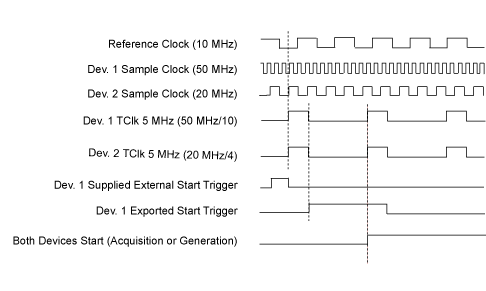NI-TClk Overview
You can use TClk synchronization to have multiple instruments simultaneously respond to triggers, to align sample clocks on instruments, and/or to simultaneously start multiple instruments. TClk synchronization is supported on National Instruments digitizers, signal generators, and digital waveform generator/analyzers that are based on the SMC technology.
The NI-TClk library allows you to synchronize NI modular instruments in the following situations:
- In a single or in multiple PXI chassis
- In a single PC
- When triggers are used for any purpose, the same or different, by an individual instrument. For example, when a start trigger from one modular instrument is used as the start trigger on another modular instrument, or when a start trigger from one modular instrument is used as the reference trigger on another modular instrument.
- When sample clock rates are equal, and also when the sample clock rates are different.
 |
Note Refer to NI-TClk External Sample Clock and External Sample Clock Timebase Considerations and NI-TClk Sample Clock Delay for more information about using the sample clocks. |
NI-TClk does not impose any limitations on the number of modules or chassis that you can synchronize.
The TClk Signal
The TClk synchronization method is based on a periodic signal used for trigger transmission. This signal is known as the Trigger Clock (TClk). The TClk signal is not shared by the devices. Instead, the TClk signal is internally generated by each device from the sample clock or sample clock timebase for that device. Sync Pulse and Sync Pulse Clock are additional signals used during TClk synchronization.
To generate TClk signals, devices must have a common reference clock (for internal sample clocks) or a common sample clock or sample clock timebase (for external sample clocks or sample clock timebases).
 |
Note Common sample clock timebases apply only to devices with decimation, such as digitizers. |
Example
The following figure shows an example of synchronizing two devices that have internal sample clocks and a common 10 MHz reference clock.

Device 1 is the Start Trigger master, with a sample clock rate of 50 MHz. Device 2 is the Start Trigger slave, with a sample clock rate of 20 MHz. The TClk frequency is 5 MHz.
The Effect of TClk on Trigger Response Time
Because devices react to TClk-synchronized triggers with delays and uncertainties that are comparable to the TClk period (200 ns or more), the trigger reaction time for synchronized devices is higher than that for individual devices. However, this condition does not impact time stamping of the reference triggers for acquisitions, so the reference trigger positions are correctly reported for TClk-synchronized devices.
Instrument Drivers and NI-TClk
Instrument drivers in the context of this document refer to libraries of VIs or functions for controlling individual devices. For example, NI-SCOPE, NI-FGEN, and NI-HSDIO are instrument drivers. NI-TClk is a library designed for use with instrument drivers.
High-level NI-TClk VIs or functions are different from typical instrument driver VIs or functions in that they accept arrays of sessions (as opposed to individual sessions). Session is a software concept for communicating and interacting with a particular physical instrument or a subset of a physical instrument. For example, you can use an NI-SCOPE session to communicate with a digitizer, and an NI-HSDIO acquisition session to communicate with the acquisition subset of a digital waveform generator/analyzer.
In LabVIEW, these sessions are obtained from your instrument driver by using the <driver name> Get Session Reference VI—for example, the niScope Get Session Reference VI. In C, NI-TClk accepts regular instrument driver sessions.
SMC Technology
For more information about the SMC technology, refer to the National Instruments Developer Zone document, National Instruments Synchronization and Memory Core—A Modern Architecture for Mixed-Signal Test.